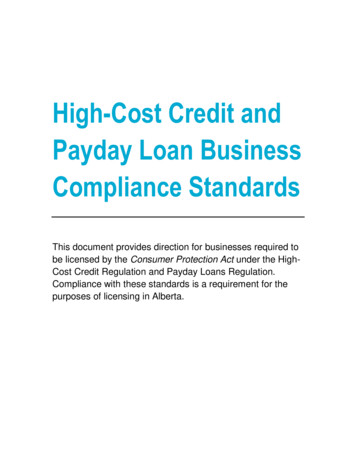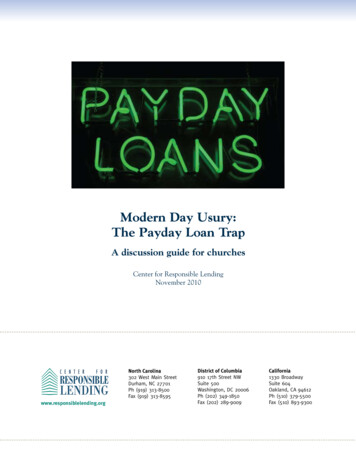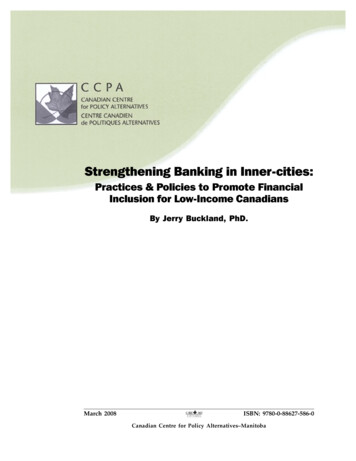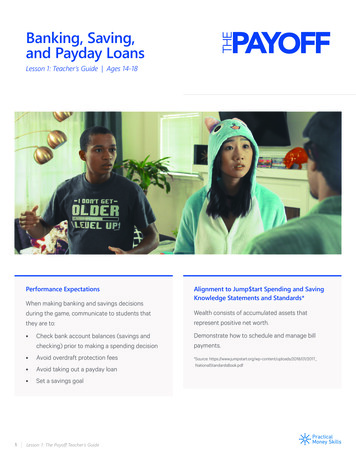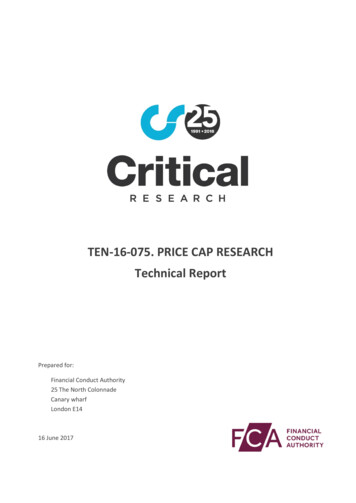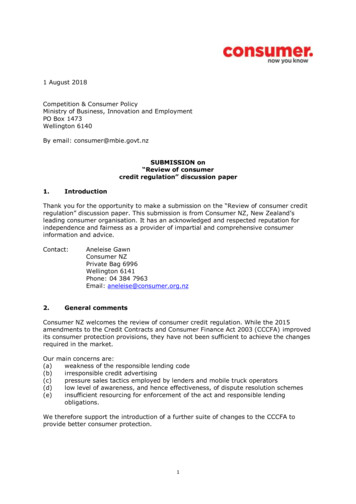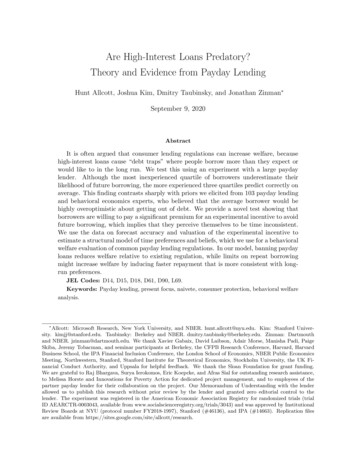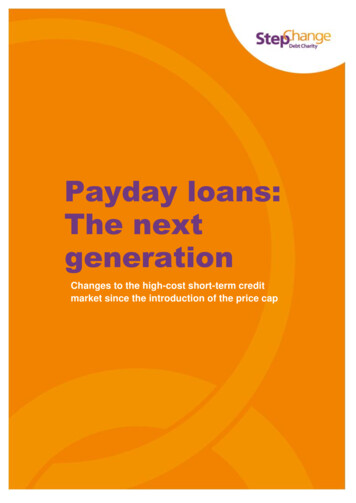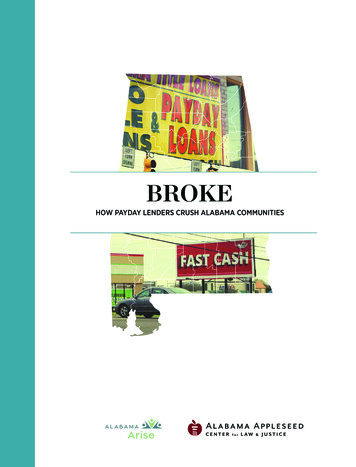
Transcription
BROKEHOW PAYDAY LENDERS CRUSH ALABAMA COMMUNITIES
About Alabama Appleseed Center for Law & JusticeAlabama Appleseed Center for Law and Justice is a non-profit, non-partisan 501(c)(3)organization founded in 1999 whose mission is to work to achieve justice and equity for allAlabamians. Alabama Appleseed is a member of the national Appleseed Network, whichincludes 18 Appleseed Centers across the U.S. and in Mexico City. Alabama Appleseed is also amember of the Sargent Shriver National Center on Poverty Law's Legal Impact Network, a collaborative of 36 advocacy organizations from across the country working with communities toend poverty and achieve racial justice at the federal, state, and local levels.For more information aboutALABAMA APPLESEED CENTER FOR LAW & JUSTICEwww.alabamaappleseed.org About Alabama AriseAlabama Arise is a statewide nonprofit, nonpartisan coalition of congregations, organizationsand individuals united in their belief that people in poverty are suffering because of statepolicy decisions. Through Arise, groups and individuals join together to promote state policiesto improve the lives of low-income Alabamians. Arise provides a structure in which Alabamianscan engage in public debates to promote the common good.For more information aboutALABAMA ARISEwww.alarise.org
BROKEHOW PAYDAY LENDERS CRUSH ALABAMA COMMUNITIES 2019 Alabama Appleseed & Alabama Arise
Report Highlightsπ Under state law, payday lenders can charge up to 456 percent APR.π More than 1.7 million payday loans were taken out in Alabama in 2018. Averagedout, that's more than 32,000 payday loans per week.π More than 200,000 Alabamians take out a payday loan every year.π Every year, Alabama borrowers pay over 100 million in payday loan fees that donot decrease the principal amount owed.π About 85 percent of payday loan borrowers in Alabama take out multiple loans in a year.π 16 states and the District of Columbia have passed APR rate caps that keep payday lenders out, meaning that 95 million Americans live in communities without payday lending. Follow-up studies have shown that access to credit was not significantlyimpacted for former payday borrowers in these states, who have turned to othermeans of credit at lower cost.π More than half of Alabamians support banning payday lending (52.5 percent).π 73.6 percent of Alabamians support a 36 percent APR cap on payday loans.π 74.1 percent of Alabamians support extending payday loan terms to 30 days.2BROKE HOW PAYDAY LENDERS CRUSH ALABAMA COMMUNITIES
CONTENTSEXECUTIVE SUMMARY. 4INTRODUCTION . . . 6PAYDAY LENDING IN OUR STATE: A HISTORY. 8BY THE NUMBERS . . . 12HUMAN IMPACT. 18FAITH LEADERS FIGHTING FOR REFORM. 32BUSINESS LEADERS FIGHTING FOR REFORM. 34ALTERNATIVE LENDING OP TIONS. 36REFORM IN OTHER STATES . . . 38RECOMMENDATIONS . . . 42CONCLUSIONS. 44ENDNOTES. 45ACKNOWLEGMENTS. 48
EXECUTIVE SUMMARYThere are more payday and title lenders inAlabama than hospitals, high schools, movie theaters, and county courthouses combined. 1 Their business model depends onchurning a profit out of desperate, financially fragile customers. Alabama providesthem with plenty. About 18.5 percent of people in Alabama live at or below the povertyline, which is 24,257 for a family of four,making us America’s sixth poorest state.2More than three-fourths of Americanworkers report living paycheck to paycheckwith little or no savings, making payday lenders a tempting option for many people withfinancial emergencies.3 But in Alabama theyhurt more than they help. Payday lendersare responsible for bringing financial hardship to hundreds of thousands of Alabamians and their families every year, swoopingin to extract profits from the struggles ofhard-working people. Unless the state Legislature decides to act, the scourge of predatory payday loans will continue to decimatefamily budgets and local economies.The Consumer Financial Protection Bureau defines a payday loan as “a short-term,high-cost loan, generally for 500 or less, thatis typically due on your next payday.”4 Theseloans are not hard to get: all a prospective borrower must do is provide proof of income and4not exceed 500 in total payday loan principals at any given time. There is no assessmentof the borrower’s ability to repay the loan,nor are there credit checks. Borrowers areasked to write a post-dated check for the fullamount of the loan plus 17.50 per 100 borrowed.5 Once they sign the check and a contract, the deal is done — sometimes in mereminutes. Across Alabama, nearly 5,000 payday loans are taken out every single day.6Though made out to be easy and fast, formost borrowers, these loans create longterm damage. The loans are not designed tobe used as advertised. The fine print on payday loans includes annual percentage rates(APR) up to 456 percent.7 With astronomical rates like that, “small-dollar,” “shortterm” loans frequently become expensive,multi-year burdens for Alabamians. Andbecause we know that 85 percent of paydayloans are taken out to cover emergencies orbills like rent, groceries, or utilities, we knowthat these long-term burdens are only making hard times harder for families across thestate.8 When these lenders sap our neighbors’ household budgets and drain moneyfrom our local economies, we all lose.In 16 states and the District of Columbia, rate caps prevent payday lenders fromoperating.9 This includes our pro-business,BROKE HOW PAYDAY LENDERS CRUSH ALABAMA COMMUNITIES
Alabama has the third highest concentration of payday lenders in the nation,and the payday lending industry extracts more than 100 million from thepockets of low- and middle-income Alabama borrowers every year in loan fees.Southern neighbors of Georgia, North Carolina, and Arkansas. There are 95 millionAmericans who live in communities wherepayday lending is no longer permitted, andif current trends continue, that numberwill only grow as more states protect theirresidents from these deceptive financialproducts.10 So far, Alabama has not. As aresult, the state has the third highest concentration of payday lenders in the nation,11and the payday lending industry extractsmore than 100 million from the pockets oflow- and middle-income Alabama borrowers every year in loan fees.12Predatory lending is a highly profitable activity. Over the next decade,lenders are on pace to take more thana billion dollars out of Alabama. Mostof that total will be siphoned out ofneighborhoods and communities badly in need of those dollars. The moneywill flow to out-of-state companiesheadquartered in states like Ohio, Illinois, Kansas, and South Carolina, andit will deepen the economic difficultiesof the Alabamians left behind.13This report brings together payday loan usage data for the state of Alabama (2015-2018), statewide publicopinion polling data, and interviewsALABAMA APPLESEED & ALABAMA ARISEwith borrowers, direct service providers,and faith leaders across the state. We founda lending system that has harmed tornadovictims, families with disabled children, veterans, and a mother with a good job who justneeded her car repaired.The overwhelming majority of Alabamians want to see payday lending either significantly reformed or banned from ourstate entirely. It is time for lawmakers tolisten to the voices of their constituentsand address the harms caused by predatorypayday lenders.5
“Doesn’t matter how many kids I had when Isaid that we were fixing to lose our home. Justdidn’t matter. They wanted their money.”TERRY KNOWLES // Huntsville Borrower6BROKE HOW PAYDAY LENDERS CRUSH ALABAMA COMMUNITIES
IntroductionTerry Knowles took out his first payday loanbecause his daughter was suffering from scoliosis, and he could not afford her care. “She’sgot it pretty bad,” he said. “We couldn’t affordany prescriptions. Couldn’t afford to loseany time out of work [for her appointments]either, but I did.” When he went to the payday lender and explained what was goingon, they expressed concern for her health.“When you first go in and you’re there to getmoney, they are sympathetic. But after it’s alldone and over with and you sign, it changes,and they know they got you.”“We needed the money,” Knowles said.“I had a kid that was in the hospital. I didn’trealize it was gonna be that expensive paying it back.”As his payday debt mounted, Knowlesand his family began to struggle keeping upwith the payments while still buying groceries. Eventually, they could no longer affordto pay rent. Knowles tried to negotiate withthe lender about making payments, but thelender wouldn’t hear it. “Doesn’t matter howmany kids I had when I said that we were fixing to lose our home. Just didn’t matter. Theywanted their money.” Knowles, his wife, andtheir young children became homeless.In the dead of winter, they were evicted from their apartment and left out in thecold. Knowles had a friend who owned atrucking company. Knowles reached out tohim, and the friend allowed the family tomove into an unheated, 400-square-foottin storage shed on the lot.“It was because of the payday loan that wehad to go to the storage shed,” Knowles said.“We didn’t have nowhere else to go. It wasALABAMA APPLESEED & ALABAMA ARISEcold. Kids didn’t have no place to sleep otherthan all together. We had to try to keep themkids warm any way we could, and it was prettytough.” The family lived in the tin shed for sixmonths. Knowles was employed and workingthe whole time. A significant portion of his income went to the payday lender.“So many times my kids would ask, ‘dad,what are we gonna do?’ And that’s a verybad feeling when you don’t know what totell them,” he said. At one point while living in the shed, with most of his incomegoing toward debt and struggling to keephis family fed, Knowles had to take out asecond payday loan to cover bare living expenses. “Some of my oldest children, theyknew what got us there,” he said. “My oldest daughter, I think she was 6 or 7, she said,‘dad, don’t do this again.’”“We should limit them to a certainamount that they can charge for theseloans,” Knowles said. “When I did that, youpay three, four times what you borrowedfrom them. There were really times whenwe needed that money. People are trying toget rich off of the poor people — people whohave doctor’s bills and kids that aren’t well,and struggling to survive and to raise theirchildren the best way they can,” Knowlessaid. And he’s right. Because while he andhis children shivered in a tin shed in NorthAlabama, a payday lender far away wasmaking a profit.PHOTOGRAPHY BYDana Sweeney7
ALABAMA HISTORYPayday Lending in Our StateThe high-interest, small-dollar, short-termlending products known as payday loans are arecent development in Alabama. For most ofthe 20th century, small loans in Alabama wereregulated under the Alabama Small Loan Act,which had an annual percentage rate (APR)below 40 percent.14 Alabama’s Small Loan Act— like similar pieces of legislation in statesaround the country — was passed to rein inthe proliferation of loan sharks at the beginning of the 20th century.15 But as banking regulations began to loosen in the last quarter ofthe century, a new industry — payday lending— began to creep into Alabama and disbursemoney at rates well above what was allowedby the Small Loan Act.16In 1994, the Attorney General of Alabama said that payday loans must be subjectto the Small Loan Act and Truth-in-Lending requirements.17 The industry had otherideas. After an intense, multi-year lobbying campaign, payday lenders succeeded ingetting the Deferred Presentment ServicesAct (DPSA) passed through the state Legislature in 2003.18 The law enabled lenders tocharge exorbitant annual percentage ratesunder the guise of origination fees for loans.Alabama has never been the same.The DPSA is an industry carve-out thatgrants payday lenders the unique power toissue short-term loans at rates that would notbe permissible for mainstream lenders. It allows payday lenders to create loans for termsas short as ten days, and permits a loan fee of 17.50 for every 100 loaned.19 Borrowers whoare unable to repay the full amount of the loanplus the loan fees at the end of their loan term8must pay additional fees to “roll over” the loaninto a new loan term. If they do not, the lenderwill forcibly take the cash from the borrower’sbank account (typically without notifying theborrower in advance) by cashing a post-datedcheck signed by the borrower when the loanwas issued, or even by directly debiting theborrower’s account.20 If the borrower does nothave sufficient funds, the lenders will clear outwhatever cash the borrower does have, oftenleaving borrowers to deal with empty bankaccounts, overdraft fees, and the balance of adebt that won’t stop growing.21A good way to understand what this loanfee and rollover structure means for borrowers is to look at how it plays out as an annualpercentage rate (APR). An APR is “used toevaluate the true cost of borrowing money,”including origination fees and other loancosts.22 The Truth in Lending Act of 1968,which envisioned APRs as “a uniform measure for comparing the cost of various credittransactions,” requires lenders to disclose thisfigure.23 The most common payday loan period in Alabama is fourteen days, which resultsin an APR of 456 percent for the most common loan structure.24 A person who borrows 250 at that rate would pay 1,140 in fees overthe course of a year, and at the end of that yearthe borrower would still owe the entire 250amount of the original loan. There would beno off-ramp for such a borrower, and no ceiling on how much they might be forced to pay.Until they could pay off the full principal debtand the rollover fees, they would be trapped.For the low-income borrowers most oftentargeted by these loans, the cycle can quick-BROKE HOW PAYDAY LENDERS CRUSH ALABAMA COMMUNITIES
ly become inescapable. If a person takes themaximum allowable 500 payday loan andcannot repay it fully, the borrower must stillpay 87.50 to roll the loan over to the next period, with no reduction at all in the debt owed.From the perspective of lenders, the trapis not a flaw, but a feature of the system thatguarantees repeat customers. In private, payday industry leaders “specifically train newemployees to encourage repeat borrowing,” asdemonstrated in this graphic pulled from the“Ace Cash Express New Hire Training Manual.”25 Though payday lenders publicly presentthemselves as essential sources of one-time,short-term emergency credit, the CEO of CashAmerica stated plainly at a 2007 conferencefor industry insiders that the payday model isto “get that customer in, work to turn him intoa repetitive customer, long-term customer, because that’s really where the profitability is.”26Indeed, nearly half of all payday loan fees comefrom borrowers who get trapped in debt cycleswhere they are taking out new payday loans ona monthly basis. In the process, household financial resources beyond those needed for essentials like rent, food and power — and sometimes even those — get diverted to roll overpayday loans to the next two-week cycle. Thisfinancial squeeze can prevent the borrowerfrom saving up any funds that might enable fullrepayment of the loan. The trap springs, andlenders secure their long-term money-makingscheme at the expense of the financially leastfortunate Alabamians.Payday Lending Drives Alabama’sRacial Wealth GapThis business model is clearly visible in thecommunities that payday lenders target. Payday loan storefronts are heavily concentrated in neighborhoods with high poverty ratesand sizable communities of color.27 Becauseof centuries of discrimination, enslavement,exclusion from social investments, and institutional obstacles to building wealth, people ofALABAMA APPLESEED & ALABAMA ARISEThe CEO of CashAmerica stated plainlyat a 2007 conferencefor industry insidersthat the payday modelis to “get that customerin, work to turn himinto a repetitive, longterm customer, becausethat’s really where theprofitability is.”EXCERPT FROM THE ACE CASH EXPRESS NEWEMPLOYEE TRAINING MANUALThe customer appliesfor a short-term loanat an ACE locationThe customer doesnot make a paymentand the accountenters collectionsThe financialinstitution (Bank, ACEor SCO) approves theloan applicationThe LoanProcessThe customer exhauststhe cash and does nothave the ability to payACE contractsthe customerfor payment oroffers the optionto refinance orextend the loanCenter for Responsible Lending, who acquired this flow chart fromthe ACE Cash Express New Hire Training ManualSOURCE9
color are disproportionately likely to have lowincomes and limited cash reserves.28The incomes of black and white Alabamians are dramatically disparate. In 2013,the median household income for white Alabamians was 49,465. African-Americanhouseholds’ median income the same yearwas 29,210 — only about 59 percent of thefigure for white people.29But as stark a picture of inequality as theracial income gap paints, it is only part of thestory. Rather, household wealth — total assetsminus total debts — is the factor that “can bethe difference between a family maintainingand strengthening their economic status orflailing in economic insecurity.”30Income does not guarantee wealth, oreven economic security. Simply put, people who own homes and have savings in thebank, the stock market, retirement accounts,or coming to them in the form of inheritances — and people whose families have accessto those kinds of assets — have far more tofall back on than those who do not.In 2011, a typical white family in the bottomincome quintile (earning less than 19,000annually) owned 15,000 in wealth. A typicalAfrican-American family earning the sameamount owned just 100 in wealth.31 In fact,due to the difference in median household networth between the races, “[t]he median Latinoor black household would have to save nearly100 percent of its income for at least three consecutive years to close the gap.”32Black families, after adjusting for household income, actually have a higher rate of savings than white families — but no family cansave 100 percent of its earnings.33 For thesereasons and many others, the income gap isjust a single factor among many present-daycontributors to the racial wealth gap, both inAlabama and nationally. Looking at overallhousehold wealth, African-American familieshave a nationwide median of 11,000 in networth compared to 134,000 held by whitefamilies.34 Data on household wealth by race isnot available for Alabama, but it is reasonableto assume the wealth gap here is significant.10Obstacles to ReformConsumer advocates in Alabama have opposedhigh-interest payday loans since they wereproposed and passed, but meaningful reform hasbeen difficult to achieve because of the significantlobbying power of the payday lending industry.During the four-year legislative cycle from 201518, payday lenders and their lobbyists madecampaign contributions of more than 400,000to elected officials here in Alabama.38 Most of thismoney was directed to legislators in key positionscapable of stalling or killing the movement ofpopular lending reform bills.39 And consistent withthe out-of-state locations of most payday lendingcompanies, more than 90 percent of the lobbyingfunds came from out-of-state lenders.40The high-cost lending industry has been wildlysuccessful at keeping reform bills from making itthrough the full Legislature, even though manylegislators have championed reform bills andexpressed support for reform. In recent years,only two modest reforms have been passedthrough the Legislature. One set the maximumpayday loan amount that a borrower may takeout at 500.41 The other required that paydaylenders keep records of the loans they make ina centralized database, which all lenders mustconsult before issuing anyone a new paydayloan.42 No person who has outstanding paydayloans that would exceed the 500 maximumshould be considered eligible for a new paydayloan under the law.43Many approaches to payday reform have died inAlabama’s Legislature over the past four years.In 2015, a bill to reduce the maximum APR to 45percent and allow a 6-month repayment perioddid not make it out of the Senate44, and a billto allow a three-month installment repaymentoption and prohibit loan rollovers failed in theHouse.45 In 2016, the Senate passed a bill to allowa six-month repayment term and to cut loan feesfrom a 17.50 maximum to a 7 maximum per 100 borrowed.46 The bill was gutted in the HouseFinancial Services Committee and was replacedwith significantly weaker reforms that would havehelped far fewer people. The House version thendied at the end of the session.There was some hope in 2016, when a bill torepeal the DPSA and prohibit payday lendingwas introduced in the House Financial ServicesCommittee, only to languish until session ended.47BROKE HOW PAYDAY LENDERS CRUSH ALABAMA COMMUNITIES
Another House bill would have made smallimprovements to the fee structure, requiredinstallment payments for borrowers who wereunable to repay, extended the minimum loan periodby 20 days, and limited people to six payday loansevery 12 months.48 It, too, failed to pass.In 2017, a bill to limit payday loans to four per12-month period, prohibit rollovers within sevendays of a prior loan, set the minimum repaymentperiod at 30 days, and automatically provideborrowers who cannot repay the loan a threemonth extension died in the Senate.49 Another2017 bill would have made several small changes,including a two-day cooling off period betweenrollovers, a 60-day repayment plan for borrowersunable to repay a loan, and an increase in theminimum loan period from ten to 14 days.50 Thatbill died in the House after an amendment wasproposed to increase the minimum repaymentperiod to 30 days.The 2018 session saw advocates concentrate ona single bill that would have brought the paydayindustry in line with the rest of the businessworld by mandating loan terms of 30 days forall payday loans.51 This change would have givenpayday borrowers more time to marshal theirfinances and repay the loans on time — enablingmore borrowers, in other words, to use the loansas advertised. It would also cut the maximumAPR to 213 percent for a two-week loan term,which is most common. The bill passed theSenate over a filibuster but was smothered in theHouse Financial Services Committee, where it wasnever even placed on the calendar for a vote.Reform advocates have proposed a host ofdifferent, reasonable, modest approaches toreform over the years. In recognition of the factthat change sometimes happens incrementally,many bills have been limited in scope, designedonly to reduce the amount of harm these loanscause to thousands of people every year. But theindustry and its allies in the statehouse have yetto pass the kinds of reforms that have helpedconsumers in many other states. Borrowers,advocates, and a bipartisan cohort of supportivelegislators have fought year after year, but reliefhas not yet come for those who are mired inunpayable debt. Fortunately, the list supportingreform continues to grow, along with theevidence of pain the current system creates.ALABAMA APPLESEED & ALABAMA ARISEOne study found that paydaylending concentration was“three times greater in AfricanAmerican neighborhoods than inwhite neighborhoods,” noting thatthe “disparity increases as theproportion of African-Americansin a neighborhood increases.”These disparities make black communities, as well as other communities of color thathave been subjected to centuries of discrimination resulting in lower levels of income andwealth, favored targets of payday lenders. Suchhigh-interest loans perpetuate Alabama’s racial wealth gap by disproportionately sappingthe finances of people of color and preventingthe accumulation of savings or wealth.Numerous studies have found that payday lenders set up shop in black communitieswith high frequency. One study found thatpayday lending concentration was “threetimes greater in African-American neighborhoods than in white neighborhoods,” notingthat the “disparity increases as the proportion of African-Americans in a neighborhoodincreases.”35 These findings have proven trueboth nationally and in Alabama, where a 2014Auburn University study found that there is “asignificantly positive relationship” betweenthe percentage of a community that is AfricanAmerican and the number of payday lendersthat open in that community.36 And becausepayday lenders are often open around theclock, parents with inflexible work schedulesfind them more accessible than traditionalbanks and credit unions. Greater financialinsecurity mixed with a high concentrationof predatory lenders drive higher rates of borrowing among people of color. African Americans are more than twice as likely as whitepeople to use payday loans.3711
BY THE NUMBERSTHE LARGE-SCALE IMPACT OF PAYDAY LENDING IN ALABAMA12BROKE HOW PAYDAY LENDERS CRUSH ALABAMA COMMUNITIES
Payday Lending in AlabamaFor more than a decade after Alabama legalized payday lending, the state had noinsight into how payday lenders were operating or how they were impacting borrowers. No data were collected or reportedto the state, and while the payday lendingindustry assured critics that their borrowers were in good hands, there was no way tosystemically verify their claim.When the Consumer Financial Protection Bureau (CFPB) began a rigorous studyof the payday lending industry in 2012, thenational investigation into the industry’simpact on borrowers began with a fieldhearing in Birmingham.52 Two years later, the CFPB released a report finding thatfour of every five payday loans were rolledover within two weeks of the loan beingmade, which is to say that the vast majorityof payday borrowers in America were getting a loan advertised as short-term eventhough most borrowers experienced longterm payday debt.53Because Alabama had no reporting requirements, the state could not be included in the research. In 2015, Alabama implemented loan reporting requirements.Payday lenders are now legally required toreport on the loans they issue within a centralized database operated by Veritec Solutions, a private company that runs paydaylending regulatory databases in more thana dozen states where payday lending is stilllegal.54 Every time a payday lender issuesa loan under this new reporting system,it must first check the names of borrow-ALABAMA APPLESEED & ALABAMA ARISEers against this database.55 The system isdesigned to ensure that no potential borrower exceeds the 500 total payday loanmaximum allowed under state law. Veritecallows Alabamians to track certain loantrends and analyze the financial cost of aloan cycle to borrowers.The new data collected since 2015 hasbrought to light what borrowers and advocates had long understood: the lending industry’s repeated claims aboutpayday loans, their purpose, and the practices ofthe industry, are false. ForTotal Employed Workforceyears, lenders sold paydayloans as emergency measures resulting from unNumber of Alabamians who tookforeseen circumstances,out at least one payday loanwhere borrowers needed a quick cash fix untilthe next payday. LendPayday loans issuedat a scale exceedingers assured legislatorsof the employed workforce in 2017and the public thatborrowers repaid theirloans and moved onwith little negative impact from the high fees.2,073,106214,42910%Veritec Solutions LLC, “Report on Alabama Deferred Presentment Loan ActivityOctober 1, 2016 through September 30, 2017."SOURCE13
AVERAGE WEEK IN ALABAMABETWEEN OCTOBER 2016 AND SEPTEMBER 201734,615HIGH-INTEREST PAYDAY LOANS 5,000PER DAYVeritec reports show this to be a fairytale. Through the years of reports, in Alabama and other states, the distribution ofloans per customer is heavily skewed toward borrowers who take out more than asingle loan per year.About 85 percent of payday borrowersin Alabama will take out multiple loans ina given year; only 15.6 percent of Alabamaborrowers in 2018 used a single paydayloan.56 In 2018, one in three payday borrowers in Alabama took out a payday loanonce a month or more.57 Perhaps most staggering, 5.7 percent of Alabamians who tookout payday loans in 2018 —11,428 borrowers— took out 24 loans or more.58 That’s a loanfor every pay period in the year — or more.More than half of all borrowers pay morefees in a year than the amount of the loanthey took out.59Between October 2016 and September2017, 214,429 Alabamians took out at leastone payday loan.60 To get a sense of scale,the size of the employed workforce in Alabama was 2,073,106 people in 2017.61 Paydayloans were issued at a scale exceeding 10percent of the employed workforce in 2017.Given that there were more than 1.8 millionhigh-interest payday loans made duringthat year, it is clear that most of those workers took out far more than one loan. Themedian number of loans taken out by a payday borrower in Alabama in 2018 was notone, not two, but seven. The average weekin Alab
"When you first go in and you're there to get money, they are sympathetic. But after it's all done and over with and you sign, it changes, and they know they got you." "We needed the money," Knowles said. "I had a kid that was in the hospital. I didn't realize it was gonna be that expensive pay-ing it back."
